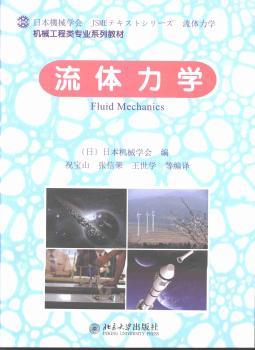内容简介
《流体力学》是日本机械学会(JSME)为了提高机械类高校学生的基础知识水平并考虑适应工程技术人员认证制度而编写的流体力学教材。全书共11章,可分成三大部分。第1章至第4章主要介绍流体力学的基础知识,包括流体基础性质、流动基础、流体静力学和准一维流动。第5章至第8章涵盖了流体力学工程应用的基本内容,包括动量定律、管内流动、物体绕流和流体运动方程式。第9章至第11章的内容包括剪切流动、势流和可压缩流动。这些知识涉及流体力学的基本概念和基础理论。全书注启发读者对流体力学相关内容的感性认知和深入思考,既有基础知识简明清晰的系统描述,又有新知识的更新拓宽。
目录
第1章 流体的性质与分类(Properties of Fluids)
1.1 概论(introduction)
1.1.1 流体力学的定义(what is fluid mechanics)
1.1.2 本书的使用方法(how to use this book)
1.2 流体的基本性质(properties of fluids)
1.2.1 密度和比重(density and specific weight)
1.2.2 粘度和运动粘度(viscosity and kinematic viscosity)
1.2.3 体积弹性模量和压缩率(bulk modulus of elasticity and compressibility)
1.2.4 表面张力(surface tension)
1.3 流体的分类(classification of fluids)
1.3.1 粘性流体和非粘性流体(viscous and in viscid fluid)
1.3.2 牛顿流体和非牛顿流体(Newtonian and non-Newtonian fluids)
1.3.3 可压缩流体和不可压缩流体(compressible and incompressible fluids)
1.3.4 理想流体(ideal fluid)
1.4 单位与量纲(units and dimensions)
1.4.1 单位制(systems of units)
1.4.2 量纲(dimension)
习题
第2章 流体流动基础(Fundamentals of Fluid Flow)
2.1 表征流体流动的物理量(properties of fluid flow)
2.1.1 速度和流量(velocity and flow rate)
2.1.2 流体的加速度(acceleration of flow)
2.1.3 压力和切应力(pressure and shear stress)
2.1.4 流线、脉线、迹线(stream line, streak line and path line)
2.1.5 流体的变形与旋转(deformation and rotation of fluid)
2.2 流动分类(classification of flows)
2.2.1 定常流动与非定常流动(steady and unsteady flows)
2.2.2 均匀流动与非均匀流动(uniform and non-uniform flows)
2.2.3 涡(vortex)
2.2.4 层流和湍流(laminar and turbulent flows)
2.2.5 多相流(multi-phase flow)
习题
第3章 流体静力学(Fluid Statics)
3.1 静止流体中的压力(pressure in a static fluid)
3.1.1 压力和各向同性(pressure and its isotropy)
3.1.2 欧拉平衡方程式(Euler's equilibrium equation)
3.1.3 重力场中的压力分布(pressure distribution in the gravity field)
3.1.4 压力计(manometer)
3.2 作用在面上的流体静压力(hydrostatic forces on surfaces)
3.2.1 作用在平面上的力(force on flat surfaces)
3.2.2 作用在曲面上的力(force on curved surfaces)
3.3 浮力和浮体的稳定性(buoyancy and stability of floating bodies)
3.3.1 阿基米德原理(Archimedes' principle)
3.3.2 浮体的稳定性(stability of floating bodies)
3.4 相对平衡状态下的压力分布(p




 VIP会员
VIP会员